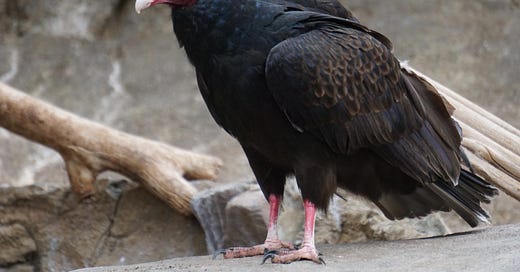Naturally
The rain had filled the birdbath. I’m pleased to have a house with a view of the water.
I was up at the whipcrack of dawn. Birdsong spilled into the morning. It’s spring training for male birds. As the morning grew older, I broke out the binoculars, unfurling the flag of my birding kingdom. The bouncy flights of shiny goldfinches delighted me, and my emotional support dandelions bloomed. To see that much of anything is thrilling.
I’d joined a gathering of endotherms at an Easter dinner. Endotherms and ectotherms are animals that regulate their body temperatures via different mechanisms. Warm-blooded endotherms generate heat internally to maintain a constant body temperature. Cold-blooded animals, or ectotherms, get heat from their surroundings, so their body temperatures change with the weather.
Q&A
Kathy Enter asked if the pair of cardinals in her yard might be the same couple as last year. On average, cardinals in the wild might live as long as 3 to 5 years. One lived 15 years, 9 months. If one of a pair is lost, the surviving bird might remain on the territory and find a new mate.
“Why is a red admiral butterfly called an admiral?” Some believe the name is a corruption of the phrase “red admirable,” with “admirable” meaning commendable or deserving of esteem. Early naturalists gave the butterfly its name because of its striking coloration. Others believe the name came from its red-orange wing markings, which resemble the chevrons of British naval uniforms.
Micah asked what bird has the longest lifespan, and the shortest. Laysan albatrosses can live more than 70 years in the wild, kakapo (New Zealand parrots) over 90 years in captivity, a bald eagle lived 38 years, a Canada goose 33 years and a sandhill crane 37 years. Cookie, a male pink cockatoo, reached 83 at Brookfield Zoo near Chicago. Small birds generally live the shortest lives. Data from the bird-banding station at Pennsylvania's Powdermill Nature Reserve found that 31% of adult male ruby-throated hummingbirds and 42% of females survive any given year. Nine years is the record longevity for that species. I don’t know which species has the shortest life.
“How can I tell a golden eagle from a bald eagle?” Their bodies are similar in weight and wingspan, with the females being larger. Golden eagles have feathers on their legs to their feet, whereas bald eagles have yellow skin on their ankles. Bald eagles have large beaks, about one-third the size of their heads, while goldens have smaller beaks. Adult golden eagles have tri-colored beaks, while the white-headed adult bald eagle beaks have a solid yellow color. Immature birds of both species have similar coloration, but a golden eagle has white wrist patches, a white tail with a distinct dark terminal band, and dark armpits. Immature balds have white-mottled plumages and white armpits.
Kent Spellman of Albert Lea wrote, “What birds am I hearing singing at dusk versus dawn?” When there is music outside my window, I’m not on Bourbon Street. I’m listening to the morning chorus. Not all our avian amigos are morning birds. Crows can be vocal before alarm-clock time, opening their day with conversation. Robins call at first light. I stayed in a hotel with a parking lot so well-lit that a robin serenaded guests most of the night. The dawn chorus is a natural phenomenon that visits the doorstep. Some might grumble about that cheery singing before the caffeine has kicked in, but the dawn chorus delights me. The reasons for the songs are the need for continual reminders of territorial ownership, an endless advertisement for mates, and to proclaim survival. Birds don't swipe right or left—they sing to find a mate. Why sing so early? Sound travels better at dawn than later in the day, and there is less noise to compete with. Who wants to sing in competition with a lawn mower? Early morning is a poor time to feed, as the light makes hunting difficult, and insect prey can become inactive during the morning chill. I listened to a brown thrasher, and I could almost hear Perry Como crooning, “Oh! It’s a good day for singing a song, And it’s a good day for moving along. Yes, it’s a good day, how could anything go wrong? A good day from morning till night!” It was going to be a good day. Dusk brings out more territorial singing than mate enticing. Catbirds, cardinals, robins, brown thrashers, owls and great crested flycatchers add their spirited voices to an evening's soundtrack.
Thanks for stopping by
“We are called to live lives of gratitude, joy, and caring, profoundly moved by the bare fact that we live in the time of the singing of birds.”― Kathleen Dean Moore.
“We all have the duty to do good.”—Pope Francis.
Do good.
©Al Batt 2025
A reader asked, “What was the first bird you ever looked at through binoculars?” They weren’t really binoculars, but I think it was a turkey vulture I saw through my Grandma Cook’s opera glasses. She had used them to watch the Metropolitan Opera on the radio. They gave me class. I’m sure the vulture was impressed. Photo by Al Batt.





Our resident house wren returned the other day and spent the whole day singing. Every. Seven. Seconds. All. Day. And the next day as well. One wonders how much energy is expended doing that much singing!
Thank you for this lovely post. Yes let’s all remember to do good and to appreciate nature’s bounty.